This story was first published in KCUR's Creative Adventure newsletter. You can sign up to receive stories like this in your inbox every Tuesday.
Here in Kansas City, we’re lucky to have an amazing variety of museums featuring art, history, sports, music and so much more.
But there’s also a swell assemblage of smaller museums in the region. They are labors of love, the product of passionate collectors and the legacy of a lifetime dedicated to the hunt.
These delightful and uniquely obscure spaces are certainly worth exploring. Most places cost less than $10 per person to visit (usually less for children, seniors and veterans) and often tours can be arranged.
As with most things these days, call ahead to confirm the museum will be open when you plan to visit, since many are run by just a few staff members or volunteers. In some cases, the founder of the collection will be on hand to share their passion with you.
C.W. Parker Carousel Museum: Leavenworth, Kansas

In the late 1890s, Charles W. Parker started his carousel business, repairing, manufacturing and shipping carnival carousels all over the United States. As the business grew, he moved his operation from Abilene to Leavenworth, Kansas. The company made over 1,000 carousels, only 16 of which still exist.
Now that legacy is preserved in the C.W. Parker Carousel Museum, which opened in Leavenworth in 2005. It’s operated by passionate and informative volunteers.
Along with exhibits about the company, the history of carnivals and carousels, the museum includes three working carousels: the 1913 C.W. Parker Carry-Us-All No. 118, a 1950 aluminum Liberty Carousel, and a hand-cranked primitive carousel circa 1850-1860, believed to be the oldest operational wood carousel in the world, though it’s no longer rideable.
You can catch a spin on the Carry-Us-All No.118, which took over 1,000 volunteer hours to restore. Bestride a horse with a corn cob behind its saddle, a Parker carousel hallmark, or one of the Kansas jackrabbits. The ride is accompanied by tunes from an Artizan A-X-1 band organ, donated by Leavenworth native Melissa Ethridge, who stopped by the museum in 2021 for a ride.
Allow yourself at least 90 minutes to explore the museum and take a ride or two. You can learn about more about our region’s carousels in this 2019 Creative Adventure.
Puppetry Arts Institute: Independence, Missouri

In Independence's Englewood Arts District, the Puppetry Arts Institute celebrates the unique legacy of Hazelle Hedges Rollins, Kansas City’s puppet maker for the world.
The company operated out of Kansas City for over 50 years. At one point, the company of 50 workers produced 1,000 puppets a week and sold more than a million puppets worldwide. They made hand and finger puppets and marionettes, both for home and educational use. Rollins held four patents for puppetry innovations.
When the factory closed in 1983, the stock — mostly consisting of thousands of puppet heads — were donated to what became the Puppetry Arts Institute. PAI opened in 2001. Today you can attend workshops (or purchase a kit) and create your own puppet with an authentic Hazelle, Inc.-designed puppet.
There’s even a little theater for kids to put on plays with their new creations, and the institute hosts puppet shows featuring professional puppeteers throughout the year.
PAI has 300 Hazelle puppets in its collection, as well as a selection of other puppets from around the world and across the decades. Rollins left much of her private collection to museums around the county, including the Smithsonian Institution, which has one of her iconic Teto the Clown puppets.
Currently on display at PAI is an exhibit honoring the Missouri Bicentennial — which includes the collection’s Harry Truman puppet. Once the exhibit ends on Aug. 31, 2022, its international puppet collection will be redisplayed.
Medicine's Hall of Fame and Museum: Shawnee, Kansas

Medicine’s Hall of Fame and Museum in Shawnee was all set to open in March 2020, until the pandemic delayed the operation. The museum officially opened that October in the former location of the Johnson County Museum, the 1927 Greenwood School.
It’s the life’s work of Dr. Bruce Hodges, who, at 89 years old, just retired as a practicing physician. He also spent time as a medical missionary, and much of the collection consists of materials he gathered during his travels over the last 50 years.
There are well over 4,000 items in the collection, relics from ancient times to the 20th century. About 80% of his collection is on display. Hodges is the curator of the museum and his son is operations director.
The museum is a self-guided experience, featuring medical artifacts, paintings, sculptures, advertisements and more. Some of the items look like torture devices now, but were considered cutting-edge technology in their own time. The collection includes an iron lung machine from the 1950s and a doctor’s Model T Ford, which still runs, as well as a buggy from 1880, which used to be in Hodges’ waiting room.
One entire room of the museum is a reconstructed early-20th century apothecary. There are also hundreds of items from African and Native American medical practices.
Hodges' museum isn't the only place you can explore the history of medicine and medical practices in Kansas City. There's the Clendening History of Medicine Museum at the University of Kansas Medical Center, available by appointment only.
Glore Psychiatric Museum in St. Joseph, Missouri, is an unusual specimen concerning the historical treatment of those with mental illness. It's a must-see for anyone wishing to discover the advancement of mental health treatments over the past 130 years.
United Federation of Doll Clubs Museum: Kansas City

Doll collecting is a fairly common passion shared by people all over the world, but did you know that the United Federation of Doll Clubs has its headquarters right here in Kansas City? In an unassuming industrial area near the Kansas City International Airport, there’s a museum stocked with over 1,000 dolls and accessories.
The organization was founded in 1943 in New York, moved its headquarters to Missouri in the 1990s and into its current location in 2001.
This museum was made possible by donations from clubs and collectors and continues to expand. It includes models from all over the world dating back to the 1700s, though a majority of the dolls are either European or American made. UFDC shares videos examining the valuable dolls in the collection.
Many are exquisitely handcrafted, more sculptural than plaything; some are mint-condition, mass-produced pieces from recent decades. There are dolls made of china, papier-mache, rawhide, cloth, wood, corn husks, shells, soap, nuts and even turkey wishbone. Drawers in the museum labeled “open me” share additional materials, such as doll dress patterns.
Can’t get enough dolls? You’re in luck. There’s also the Doll Museum in St. Joseph, Missouri, and, of course, the exquisite dollhouse collection and vintage toys of the National Museum of Toys and Miniatures on UMKC’s Volker Campus.
National Silk Art Museum: Weston, Missouri

Housed in the old Bank of Weston, the National Silk Art Museum is truly one-of-a-kind. Local business owner John Pottie is the founder and curator, having collected silk art for over 40 years and accumulating over 500 examples of the art form. The museum opened in 2013 and rotates its collection regularly.
It includes pieces from over 200 years ago, from 19th and 20th century England, France, Germany and the United States. Though many of the works are reproductions of oil paintings, each took years to make and are each unique.
Many were created with the jacquard weaving technique, which used an intricate system of punch cards, a precursor to the calculator and computer. The museum has a jacquard loom from Germany on display, as well as information about the history of weaving.
They share examples of individual pieces regularly on Facebook, with information about the context and creation of each piece.
Get while the gettin's good

Perpetuity can be persnickety. Passions and energies shift, collections outgrow their spaces, new deals lure collections to other locales.
For instance: Leila’s Hair Museum in Independence. KCUR’s Suzanne Hogan profiled collector Leila Cohoon in 2020 for the podcast A People’s History of Kansas City. It’s not currently open to the public, having closed during the pandemic.
The Arabia Steamboat Museum, a jewel of the River Market, displays the contents of the 1856 sunken steamboat. With another newly discovered and excavated steamboat, the Malta, the organization is looking to expand its collection and create the National Steamboat Museum. It's unlikely the museum will stay in Kansas City.
The Evel Knievel Museum, founded in Topeka, Kansas, is planning to move to Las Vegas in the next year or so. KCUR’s Frank Morris visited the museum when it first opened in 2017.
But who knows what the future holds for offbeat museums in Kansas City? Founders of the LUMI Neon Museum have been saving and restoring iconic neon signs since 2017. They are in talks to team up with the Kansas City Auto Museum (currently located in Olathe), looking for a permanent home in downtown Kansas City.
Want more adventures like this? Sign up for KCUR's Creative Adventure Email.






